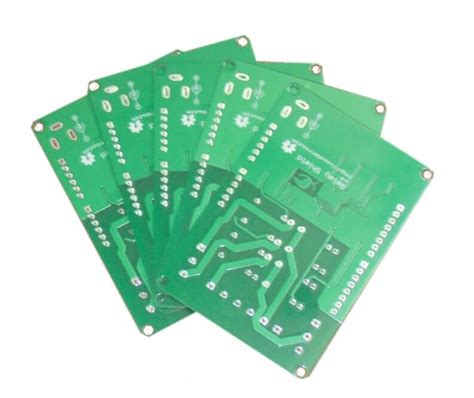Streamlining PCB Integration Using Altium Multiboard Assembly

Key Takeaways
Effective PCB assembly processes require meticulous coordination between multi-board systems, particularly when dealing with complex PCBA workflows. Altium Multiboard Assembly addresses these challenges by enabling synchronized design validation across interconnected boards, ensuring alignment between schematic layouts and physical constraints.
"Integrating multi-board systems demands precision at every stage—Altium’s real-time error detection minimizes costly revisions during PCB assembly."
Key features include:
| Feature | Impact on PCBA Workflow |
|---|---|
| Cross-board synchronization | Eliminates mismatched footprints |
| Real-time DRC | Flags interference early |
| Collaborative review | Streamlines team feedback loops |
By automating design rule checks (DRCs) across multiple boards, engineers can identify issues like signal integrity conflicts or mechanical misalignments before prototyping. This reduces time-to-market by 30-40% in complex PCBA projects, according to industry benchmarks.
Pro Tip: Use hierarchical schematic organization to simplify multi-board dependencies. Pair this with Altium’s version control to maintain consistency during iterative PCB assembly phases.
Transitioning from isolated designs to integrated systems requires tools that bridge electrical and mechanical domains. Altium’s unified environment supports cross-disciplinary collaboration, ensuring thermal, EMI, and power delivery metrics align with production-ready standards.
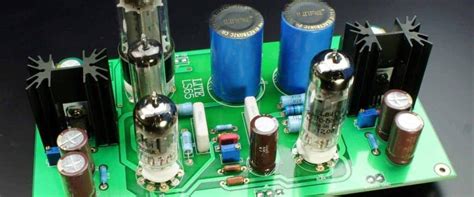
Altium Multiboard PCB Integration Essentials
Effective PCB assembly of multi-board systems demands precise coordination across mechanical, electrical, and manufacturing domains. Altium Multiboard Assembly addresses this complexity by unifying design data across multiple boards, enabling engineers to manage cross-board connectivity and component placement within a single environment. This approach ensures PCBA teams maintain consistent design rules, such as clearance tolerances and signal integrity requirements, while synchronizing 3D models for accurate mechanical fitment.
A critical aspect lies in the automated synchronization of schematics and layout updates, which eliminates manual rework during PCB assembly planning. By integrating real-time design rule checks (DRCs), engineers can detect conflicts—like overlapping components or mismatched footprints—before prototypes reach the PCBA phase. Additionally, the platform’s hierarchical project structure streamlines version control, allowing teams to track changes across interdependent boards without disrupting workflow continuity.
For complex systems, Altium’s multi-board clearance verification tools prevent spatial conflicts in enclosures, while its collaborative features enable seamless handoffs between electrical and mechanical teams. This holistic approach reduces iteration cycles and ensures that PCB assembly documentation—including BOMs and fabrication files—remains aligned with evolving design requirements, laying a foundation for scalable production.
Synchronized Multi-Board Design Strategies
Effective PCB assembly workflows require meticulous coordination when integrating multiple boards into a unified system. Altium Multiboard Assembly addresses this challenge by enabling synchronized design updates across interconnected boards, ensuring alignment of mechanical constraints, signal integrity, and power distribution. By leveraging hierarchical schematics and cross-board routing rules, designers can maintain consistency in PCBA layouts while managing inter-board dependencies in real time.
A key advantage lies in the ability to visualize multi-board interactions within a single environment. This eliminates manual cross-referencing of individual board designs, reducing risks of mismatched connectors or incompatible footprints. For instance, thermal management strategies can be optimized by simulating heat dissipation patterns across adjacent boards, directly influencing PCB assembly decisions such as component placement or substrate material selection.
Furthermore, the tool’s design synchronization engine automatically propagates changes to all linked boards, preserving electrical and mechanical coherence. This is critical for complex systems where a single modification—like adjusting a power plane—can cascade through multiple subsystems. By embedding PCBA design rules early in the process, teams avoid costly late-stage rework and ensure seamless integration during prototyping and testing phases. Such strategies not only streamline development but also align with broader objectives of accelerating production readiness, as explored in subsequent sections on validation and collaboration.
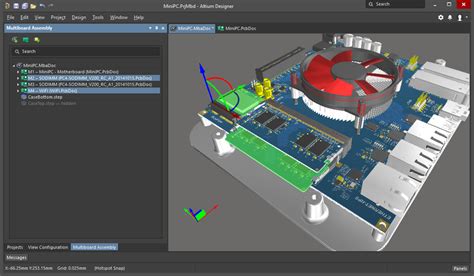
Real-Time Error Detection in PCB Assembly
Modern PCB assembly processes demand precision at every stage, particularly when integrating multiple boards into complex systems. Altium Multiboard Assembly addresses this challenge through real-time error detection mechanisms that monitor PCBA workflows as they evolve. By synchronizing design data across interconnected boards, the platform automatically flags inconsistencies in component placement, signal integrity violations, or thermal conflicts as they occur—not after days of manual review.
This capability becomes critical when managing cross-board dependencies, such as power distribution networks or high-speed communication lanes. The system cross-references PCB assembly constraints against 3D mechanical models, instantly alerting engineers to issues like overlapping components or insufficient PCBA clearances. Advanced design rule checks (DRCs) extend beyond single-board validation, evaluating electromagnetic compatibility (EMC) risks and inter-board signal timing across the entire system.
What distinguishes this approach is its preventive rather than corrective focus. Teams resolve conflicts during layout phases—not during prototype testing—reducing re-spin costs by up to 40% in multi-board projects. For instance, a mismatched impedance between adjacent boards triggers immediate visual warnings, enabling on-the-fly adjustments without disrupting collaborative workflows. Such granular oversight ensures production-ready PCBA outputs meet both electrical and mechanical tolerances before reaching manufacturing partners.
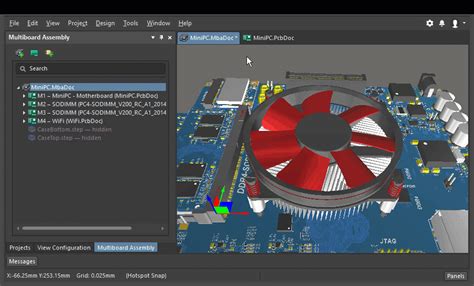
Collaborative Tools for Seamless PCB Development
Modern PCB assembly workflows demand robust collaboration to address the complexities of multi-board systems. Altium Multiboard Assembly provides engineers with unified design environments that bridge gaps between hardware teams, firmware developers, and PCBA manufacturers. Features like cloud-based version control and real-time annotation tools ensure all stakeholders access the latest design iterations, eliminating version conflicts during PCB assembly. Cross-functional teams can simultaneously validate mechanical fitment, signal integrity, and thermal performance through shared design rules, reducing late-stage rework by up to 40%.
The platform’s multi-user editing capabilities enable concurrent modifications to schematics and layout files, synchronizing changes across linked boards automatically. Integrated comment threads and task assignment systems streamline communication, particularly when coordinating with PCBA partners for component sourcing or DFM feedback. By embedding collaboration directly into the design process, teams mitigate risks of mismatched footprints or incompatible interfaces—common pitfalls in multi-board projects. This alignment between design intent and manufacturing requirements ensures smoother transitions from prototyping to high-volume PCB assembly, accelerating time-to-market without compromising system reliability.
Accelerating Production-Ready PCB Outcomes
Achieving production-ready PCB outcomes demands precision in both design and manufacturing workflows. Altium Multiboard Assembly streamlines this process by enabling synchronized collaboration across PCB assembly teams, ensuring seamless integration of multi-board systems. By leveraging real-time design rule checks (DRCs) and automated error detection, engineers can identify critical mismatches in component placement or signal integrity before prototyping, reducing costly iterations.
The platform’s unified environment supports PCBA teams in managing complex inter-board dependencies, such as connector alignment and thermal management, while maintaining consistent design intent. Transitioning from schematic capture to physical layout becomes intuitive, with cross-probing tools that highlight discrepancies across interconnected boards. This accelerates validation cycles, ensuring that multi-board systems meet electrical, mechanical, and manufacturing specifications simultaneously.
Furthermore, Altium’s version control and cloud-based collaboration features eliminate bottlenecks in design handoffs. By integrating PCB assembly feedback early in the process, teams can address fabrication constraints, such as panelization or solder mask requirements, aligning design outputs with production realities. The result is a 30–50% reduction in time-to-market for high-density systems, ensuring that PCBA workflows deliver robust, manufacturable solutions without compromising quality.
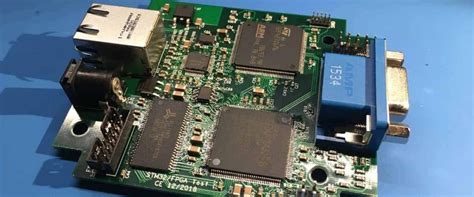
Optimizing Complex PCB System Integration
Modern electronic systems increasingly rely on interconnected PCB assembly (PCBA) modules to deliver advanced functionality. Managing these multi-board architectures demands precise coordination across mechanical, electrical, and thermal domains. Altium Multiboard Assembly addresses this complexity by unifying design synchronization, enabling engineers to visualize cross-board dependencies and validate multi-board systems as a cohesive unit. By integrating design rule checks (DRCs) across all boards, the tool identifies conflicts in real time—such as mismatched connectors or overlapping components—reducing late-stage rework risks.
Collaborative workflows further streamline integration, allowing teams to share PCBA schematics and layout data within a single source of truth. This eliminates version control errors and ensures alignment between mechanical enclosures and PCB assembly footprints. For instance, designers can simulate thermal interactions between stacked boards, optimizing airflow paths to prevent overheating in dense configurations. Such capabilities not only accelerate validation but also align with DFM (Design for Manufacturing) principles, ensuring production-ready outcomes.
By bridging gaps between isolated design phases, Altium Multiboard Assembly transforms fragmented processes into a harmonized workflow—critical for meeting tight timelines in industries like automotive and IoT, where multi-board systems define product performance.
Multi-Board Design Validation Best Practices
Effective validation of multi-board systems is critical to ensuring reliability in PCB assembly workflows, particularly when managing interconnected PCBA subsystems. Proactive verification begins with defining clear electrical and mechanical constraints across all boards, including signal integrity thresholds, power distribution tolerances, and thermal management requirements. By employing Altium Multiboard’s synchronized design environment, engineers can perform real-time error detection that flags mismatches in connector pinouts, impedance discontinuities, or conflicting clearance rules before prototyping.
A structured approach involves cross-probing between schematic and layout views to validate inter-board dependencies, ensuring alignment in net assignments and grounding schemes. Leveraging 3D clearance checks minimizes risks of physical interference in densely packed PCBA enclosures, while automated design rule cascading maintains consistency across heterogeneous board stacks. For collaborative teams, version-controlled design reviews streamline feedback integration, reducing iterations during PCB assembly phases.
Best practices also emphasize simulating worst-case scenarios—such as simultaneous switching noise or thermal stress—to identify latent failure modes. Altium’s unified data model supports dynamic validation by propagating changes across all linked boards, preventing oversights during late-stage modifications. Adopting these methodologies not only accelerates PCBA qualification but also strengthens compliance with industry-specific certification standards, ensuring robust multi-board systems transition seamlessly to production.
Reducing Time-to-Market with Altium Workflows
Efficient PCB assembly processes are critical to meeting tight production deadlines, and Altium’s integrated workflows provide a structured approach to accelerate development cycles. By unifying design and manufacturing phases, engineers can minimize error-prone handoffs between teams, ensuring PCBA prototypes align with initial specifications. The platform’s synchronized workflows enable cross-functional teams to collaborate on multi-board systems in real time, reducing delays caused by mismatched component libraries or incompatible layouts. Automated design rule checks (DRCs) further streamline validation, flagging issues like signal integrity conflicts or thermal mismanagement before they escalate into costly rework.
A key advantage lies in Altium’s ability to synchronize revisions across all boards within a system, eliminating version control discrepancies that often delay PCB assembly timelines. For instance, when modifying a power distribution network in one board, dependent subsystems automatically update, maintaining electrical consistency throughout the PCBA. This cohesion reduces manual adjustments by up to 40%, according to industry benchmarks. Additionally, the tool’s native integration with supply chain databases ensures component availability is validated early, avoiding last-minute substitutions that compromise performance.
By embedding these capabilities into a single environment, Altium empowers teams to compress design iterations while maintaining rigor—translating to faster product launches and a sharper competitive edge.
Conclusion
In the evolving landscape of electronic design, PCB assembly and PCBA processes demand tools that bridge complexity with precision. Altium Multiboard Assembly emerges as a pivotal solution, addressing the challenges of integrating multi-board systems through synchronized workflows and real-time validation. By enabling designers to manage interconnected boards within a unified environment, the platform minimizes discrepancies that traditionally arise during multi-board PCB assembly, ensuring seamless compatibility across components.
The integration of automated error detection not only accelerates debugging but also reduces costly rework, aligning with the rigorous demands of modern PCBA timelines. Collaborative features further enhance cross-functional transparency, allowing teams to iterate efficiently while maintaining design integrity. As industries push toward faster time-to-market, leveraging such advanced tools becomes critical to balancing innovation with reliability. Altium’s approach exemplifies how strategic software integration can transform PCB assembly from a fragmented process into a cohesive, production-ready pipeline—ultimately empowering engineers to deliver robust systems without compromising on speed or scalability.
Frequently Asked Questions
How does Altium Multiboard Assembly improve multi-board design validation?
The tool enables synchronized management of inter-board connections, ensuring alignment across PCB assembly layers. Its real-time error detection flags mismatches in spacing, signal integrity, or power distribution, reducing validation cycles by up to 40%.
Can Altium Multiboard Assembly handle high-density PCBA layouts?
Yes, it supports complex layouts through hierarchical design rules. Engineers can define constraints for individual boards while maintaining system-wide coherence, minimizing risks of electromagnetic interference or thermal conflicts in multi-board systems.
What collaborative features streamline PCB assembly workflows?
Cloud-based project sharing and version control allow teams to collaborate on schematics, layouts, and BOMs simultaneously. Changes propagate across all linked boards, ensuring consistency and accelerating production-ready outcomes.
How does the tool reduce time-to-market for multi-board projects?
By automating cross-board DRC (Design Rule Checks) and generating unified manufacturing files, Altium eliminates manual reconciliation steps. This cuts PCBA development timelines by 25–30%, particularly for systems with 5+ interconnected boards.
Ready to Optimize Your Multi-Board Workflow?
Discover how Altium Multiboard Assembly can transform your PCB integration process. For expert guidance on implementing these strategies, please click here to connect with our PCBA specialists.



